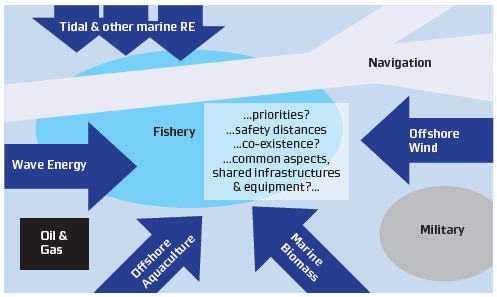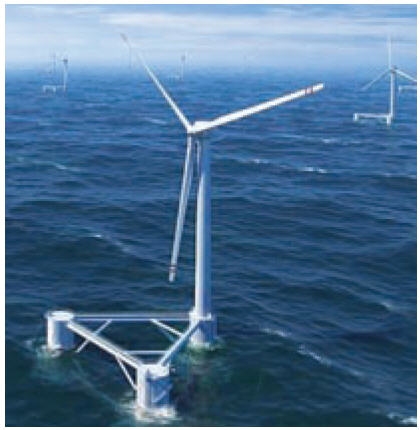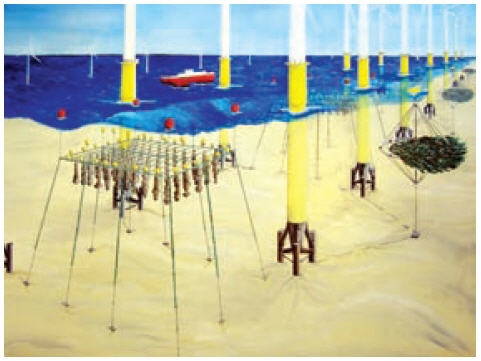

Article from the OES Annual Report 2009
Author: Frank Neumann, WavEC, Portugal
The Future of Ocean Space: a Crowded Usage?
The increasing ambitions of implementing ocean energy technologies on a large-scale have led to discussions about the conflicts of use of the ocean space, mainly with respect to traditional competing uses, but also among the new ‘competitors’ in the field of maritime renewables. To date, this situation has been generally recognised at a generic, but not detailed, level (see e.g. Waveplam, 2009).
With terrestrial resources approaching their physical limits, ocean space has increasingly been considered as a last resort for a number of vital resources of modern society, in particular for energy conversion, minerals, biomass and food. Territorial waters are subject to increased economic interest, which is why tools like Marine Spatial Planning (MSP) and Integrated Coastal Zone Management (ICZM) have become major issues on the political agenda in the European Union (EU) and beyond. While ICZM has been implemented for a long time in most developed coastal areas, future-oriented and consistent decision-making needs to be extended towards the offshore region in the present context. Instead of some usages replacing others, it is likely that traditional usages of ocean space continue or even increase, while new and competing uses will equally require large areas.
Such a scenario requires a new level of sensibility on the decision-making level, both with respect to priorities, possible co-existences and cross-border aspects.

Figure 1: Sketch Of Increasing Density And Variety Of Ocean Space Uses:
The New ‘Competitors’
On the national level, some countries have started to implement detailed and structured approaches to regulation and avoiding conflicts of ocean space use, including the emerging sector of electricity generation from marine renewables. In particular in the UK, the Department for Environment Food and Marine Affairs (DEFRA) has established a widely accepted definition of the term Marine Spatial Planning, showing the ambitious targets of the process:
“Marine spatial planning provides an opportunity to take a strategic plan for regulating, managing and protecting the marine environment that addresses the multiple, cumulative and potentially conflicting uses of the sea”.
The process of yielding a binding legal framework to this extent, originated in the year 2002 (DEFRA, 2002), has recently yielded the Marine and Coastal Access Actin 2009 (DEFRA, 2009).
The rapid increase of large-scale offshore wind farms contributed to the importance that this issue has been given in the UK, and certainly the existence of high level discussions involving several public documents and consultation periods has, in turn, been beneficial for the acceptance of large-scale offshore wind farms. However, each technology has its own specific coastal and maritime space issues, and geographic factors strongly influence the usage scenarios involving marine renewables.
Therefore, there is a strong need for more detailed technical inputs for such documents, as well as for an integration of cross-border relevant aspects and a global understanding of priorities and co-existence.
The Need For More Structured Planning & Consenting
Every sector considers its own performance and contributionas the most relevant to society, and as long as its economic activities remain autonomous, the requirement for co-existence or even synergies with other sectors, potentially competing for access to the same areas, is not a priority. In this context, ocean energy will not only ‘compete’ with existing ocean uses but also with other new activities considered vital for modern society. Therefore, quantitative and objective means of measuring the (socio) economic value and consequently attributing priority usages for certain areas will be an important tool for future marine spatial planners. Socio-economic evaluations exist for traditional sectors (e.g. fishing), but others are difficult to quantify (e.g. military uses). The socio-economic value of marine renewable energies still has to be evaluated, although conventional offshore wind (bottom-fixed farms in shallow water; <40m) provide some evidence. If an acceptable approach for such quantification can be found for the entire range of competing uses, the most optimal and beneficial uses of ocean space can be guaranteed.
Given the scenario of potentially ‘crowded’ territorial waters, the most interesting areas for marine renewable energy conversion, namely shallow to intermediate water depths (30 – 200m) relatively close to the coast, are intrinsically subject to the highest competition. From the perspective of ocean energy and its comparatively weak lobby, it is vital for the emerging sector to create awareness of its needs, and to procure strategic allies since there are no presumed preferential rights. Further, the high capital-intensity connected with moderate revenue and capital return performance in the early years of development make it vital for ocean energy to be proactive in highlighting and pursuing potential synergies with other sectors. In addition to direct economic benefit in case of synergetic co-existence, ocean space can be used in a more efficient way, which in turn should count in favour of such combinations in the process of MSP. A good example of the growing interest in such synergies is therecent call of the European Commission for projects that address combined platforms for wave and offshorewind energy.
Overall, more detailed consequential investigations are needed in order to yield a reasonable and efficientco-existence of future sea uses. Thus, MSP should been abled and take into account the following aspects:
(i) Quantified (socio) economic value (e.g. per squarekm) of different usages; the outcome must be adirectly comparable quantity, however local and regional priorities and in particular environmental acceptance must be taken into account;
(ii) Existence of synergy potential between different usages based on their space use and technical characteristics with respect to dimensions, materials, installation and O&M needs (increase invalue for any combined uses).
The remainder of this article is an attempt to outline the needs for ocean space and characteristics of the most likely major potential ‘rivals’ of ocean energy (in particular wave energy, due to its expected large-scale implementation in territorial waters) for future ocean space use, as well as to highlight some potentially important synergies. Simultaneously, it is a call for more detailed and pro-active investigations on technical and procedural synergies of ocean energy with other usages.
Existing Uses of Territorial Waters
In the following section, the expected usages of the ocean space are briefly outlined, in particular with respect to their characteristics regarding potential conflicts and co-existence, or even synergies, with ocean energy. It should be noted that typical ‘conflicts of uses’ are no-go areas, some of which are not generally linked to a certain usage or not easy to evaluate on the background of the purpose of this article. Such obstacles can be existing cable routes (mainly for telecommunication but also electricity transmission cables), pipelines, scientific research areas, including sites of (potential) archaeological interest and specific biosphere reserves, as well as dredge spoil disposal sites and their safety perimeter. Such conflicts are not the scope of this discussion, as there is neither a way to reasonably quantify their comparable benefits, nor to procure synergies with ocean energy.
Navigation & Safety
Large-scale wave energy farms might be planned in areas that are intensely used for navigation purposes. The characteristics of commercial ship traffic and leisure or small craft interaction are distinct:
Fishing
Fishing is by far the most wide spread and well-establishe usage of ocean space, and, due to the strong traditions of the sector and the constantly increasing need for seafood, it is considered a vital activity. In addition to the same navigational risks as for other ships, the opposition of fishermen communities to potential no-go areas due to ocean energy farms is a widely discussed issue.
(i) the direct economic benefit of each activity,and
(ii) whether there is in fact a conflict,
or whether synergies between these uses could even outweigh the conflict potential. From a pragmatic viewpoint, an increased presence of ‘smart’ offshore infrastructures would also benefit the fishing community, as verification of catch quota and mutual respect of boundaries increases the fairness of this activity. It is further likely (though not yet proven) that large no-go areas caused by the ocean energy farms function like sanctuaries and actually improve the habitat to an extent that livestock may recover significantly. Based on the continuous decrease of livestock of important fishing species, such a scenario would directly benefit the fishing sector.
In any case, there will be the need to reconcile large-scale ocean energy with the fishing industry, and synergy potential does not seem to be significant from a technical viewpoint.
Military and Surveillance
The existence of designated areas for military use typically excludes the implementation of marine renewables. On one hand, it must be verified – on a case-to-case basis – to what extent such areas need to persist in the same dimensions and, to the same extent, as compared to times where no other large scale uses than fishing existed. In many cases, a possible relocation of such areas further offshore might be a valid option. On the other hand, with ocean energy installations becoming a reality along large parts of the coastlines, military field exercises should also recognize this reality, so in some cases super position might be acceptable. Certainly there is synergy potential for other military uses, namely related to surveillance of traffic and intrusions, including the increasing problem of drug traffic. Properly instrumented (radar, visual and acoustic devices), offshore wave energy farms can substantially contribute to monitoring territorial waters. It should be reminded that some wave energy applications have been supported in recent past having in view autonomous military uses.
Oil & Gas Exploration & Production
To a similar extent to fishing, oil & gas exploration and production activities have dominated some areas of ocean space. The relationship between these activities and ocean energy is two-fold:
Oceanography and Other Marine R&D
Provided that ocean energy does not significantly impact with the physical and biosphere environment, more synergies than conflicts can be expected for oceanographic and other R&D activities. Except for specific large-scale baseline studies, where a native environment is required for proper results, marine renewables infrastructures can serve as monitoring stations for meteorology, water properties and livestock survey, among others.
Competing New Uses (Aspirants)
Marine Renewable Energy – Offshore Wind Offshore wind energy has been the fastest growing renewable energy source and is a reality in relatively shallow waters, mainly in the UK and the Baltic regions. The expansion of the ‘shallow-water’ technology is somewhat limited and many coastlines are too deep for further growth. On the other hand, particular floating wind farms are likely to become a major contestant for areas that are suitable for wave energy. Several technologies (Hywind, Sway, WindFloat (Figure 2)) have reached a credible development status, and their technical properties indicate large potential for combined use with ocean energy devices.

Figure 2: Artist’s Impression Of Windfloat Concept: Various Technical Synergies With Wave Energy Devices (Picture Courtesy of Principle Power Inc.)
Floating wind farms are typically moored in 50 – 200m deep water, and their distance would generally allow wave farms to be installed in-between (in an advanced stage, once mooring systems of different floating devices might be combined). There are further possibilities of direct integration of Oscillating Water Columns (OWCs) in the structures of floating wind farms, and floating and submerged point absorbers might be used for catenary mooring systems. In addition to the more efficient use of materials and equipment, common installation and O&M activities can be explored.
Marine Biomass
Marine biomass is often included in the term of ‘aquaculture’ (see next section), while biomass itself is a term usually connected to renewable energy. However, in this article it is considered separately, being aquaculture related to fish and seafood (livestock) farming. Recently the large-scale ‘farming’ of marine biomass in offshore installations has become the subject of substantially increased interest, partly as a consequence of its potential for CO2 sequestration. The development of industrial-scale algae bio-reactors is starting to be planned for production of carbon-neutral bio-fuels, high value food colourings, pharmaceuticals, cosmetics, dietary supplements, edible seaweed, animal feed, soil improvers, and fertiliser. Ultimately, area-wide implementation of algae cultivation has been proposed for direct CO2 sequestration.

Figure 3: Example Of Multifunctional Maritime Traffic Zones As Proposed By AWI. Picture from www.awi.de/en/research/new_technologies/marine_aquaculture_maritime_technologies_and_iczm/
Among other research activities world-wide, the German Alfred Wegener Institute (AWI) has investigated offshore cultivation of marine macro algae under harsh environmental conditions since the mid-nineties, and already proposed multifunctional ocean space use in connection to offshore wind farms several years ago, including solutions for traffic organisation in such areas (Figure 3; Buck et al., 2004).
In addition to low potential competition for ocean space, since marine biomass cultivation could be implemented further offshore, marine biomass production has an obvious synergetic potential in connection to ocean energy, in particular with respect to the joint use of offshore infrastructures (e.g. mooring lines, monitoring devices) and joint O&M. Further, marine biomass cultivation could potentially be incorporated in ocean energy installations, due to the large variety of potential technical requirements. Finally, ocean energy devices could be used to provide energy for the marine biomass cultures, which was recently announced as one of the commercial approaches to synergetic marine biomass and ocean energy production by the Marine Sector of the British C-Questor group.
Offshore Aquaculture
Open water offshore aquaculture for fish and seafood production on a large-scale has been increasingly considered a sustainable alternative for satisfying the massive needs of human consumption. While open-ocean fishing is reaching physical limits and some species are moving towards extinction, pond aquaculture is land intensive and expensive, and the quality of the products is questionable. Due to being in open waters, offshore cages are subject to natural water circulation and quality, health and environmental issues are drastically reduced. Offshore aquaculture had been a vision for more than a decade, however only in recent past significant advances have been made, for example through the Hawaii Offshore Aquaculture Research Project (HOARP, see Billig, 2009 & Figure 4) that uses a large bi-conical steel cage for survivability in waves up to 8m. Meanwhile, credible commercial approaches to submerged offshore cages have been developed, for example the Ocean Globe from the Norwegian company Byks (Figure 5), the Aquapod from the US company Oceanfarmtech, and the Sea Station from the US company Oceanspar.
Goudey (2008) and Kite] Powell (2008) give a comprehensive overview of the state of the art and currently most relevant issues of the sector. Despite its large potential and technical viability, offshore cage aquaculture faces a dilemma similar to offshore renewable energies: costs are still multiples of costs for aquaculture in nearshore protected waters, mainlys consequence of the high mooring and O&M costs. Successful implementation of automated operating procedures for minimising labour, improved safety and further reduction of environmental impacts are the most relevant items for making offshore aquaculture viable, and this could well be possible by sharing ocean space and infrastructures with ocean energy, in particular large-scale wave energy farms. To a similar extent like marine biomass, ocean energy can equally be used to power large-scale open water aquaculture.
Conclusions
The increasing density of ocean space use and the relatively low priority ocean energy has experienced in the political agenda to date call for improving the growing sector’s positioning for future implementation phases. In order to ensure strong, sustainable growth of ocean energy, its secondary uses, and synergies with existing and other new activities, have to be fully explored. In particular, wave energy and floating offshore wind farms appear suitable to coexist; in addition, marine biomass farming and/or large-scale offshore seafood aquaculture hold a large potential for technical synergies with wave and/or offshore wind farms. In general, these synergies consist of common use of mooring systems, installation processes, O&M equipment and personnel. In the early implementation phase of marine energy farms such synergies can naturally not be exploited, as survivability and other technical issues need to be fully addressed first. However, once technical solutions for such combined uses are developed, the viability and acceptance of ocean energy and other uses will be substantially increased. Therefore, such synergies must be investigated at an early stage and stakeholders from different fields should be incentivised to collaborate on this issue.
Figure 4: HOARP Demonstration Project Picture from www.oar.noaa.gov/spotlite/archive/spot_hawaii.html
Figure 5: Artist’s Impression of OceanGlobe Installation
Picture from www.byks.no
In this context, current legislation and consenting procedures appear biased towards traditional, or simply the most capital-productive uses, which calls for correction towards more objective and neutral evaluation procedures for deciding upon priorities for oceanspace use. Such procedures should include a quantification of the weighted socio-economic benefit of eachuse. Further, the factor of secondary uses and synergy potential should be accounted for by default in future actions of marine spatial planning. Finally, a much stronger international collaboration must be enforced to enable an integrated approach, not limited to European waters.
Acknowledgements
The author acknowledges the support by the EC-Intelligent Energy-funded project Waveplam.
References
Billig, Priscilla: Offshore Aquaculture Project Yields a Traditional Hawaiian Delicacy; University of Hawaii Sea GrantCollege Program
Buck, B. H.; Krause, G.; Rosenthal, H.: Extensive open ocean aquaculture development within wind farms in Germany: the prospect of offshore co management and legal constraints; Ocean & Coastal Management 47 (2004) 95 122
DEFRA: SAFEGUARDING OUR SEAS – A Strategy for the Conservation and Sustainable Development of our Marine Environment, 2002
DEFRA: MARINE AND COASTAL ACCESS ACT 2009; Office of Public Sector Information (OPSI), 2009
Goudey, C. A.: Offshore Aquaculture Technology in the PacificNorthwest; Forum on Offshore Aquaculture in the PacificNorthwest Newport, OR 9-10 September 2008Kite]Powell, H.L.: Taking Finfish Aquaculture to the Open
Ocean: U.S. Experience and Prospects; AQUA SUR 2008,International Exhibition in Latin America Aquaculture; PuertoMontt, Chile; March 26 – 29, 2008
Waveplam, 2009: Del. 2.2: Non-technological Barriers to WaveEnergy Implementation; Final Version – March 2009;EC-EACI-funded project EIE/07/038/SI2.466832 Waveplam.
-----------------------------------
German Alfred Wegener Institute (AWI)
University of Hawaii Sea Grant College Program
DEFRA: MARINE AND COASTAL ACCESS ACT 2009